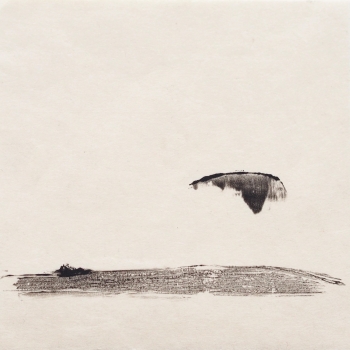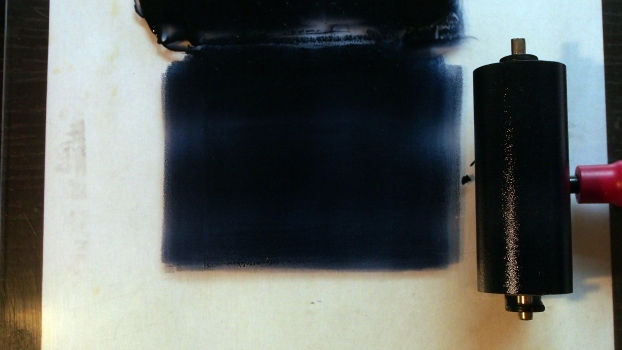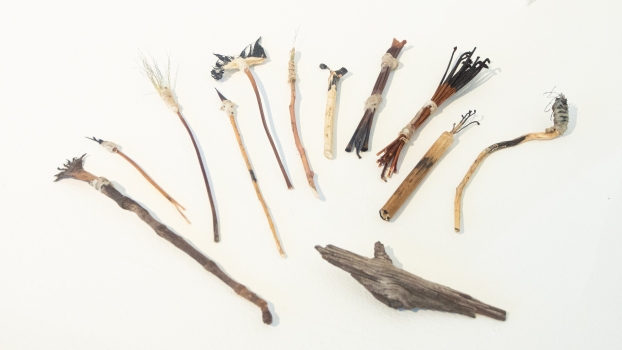Selected contemporary artists from the exhibition Steamers, Dykes, Dramas: Henrieke Strecker is a wanderer who repeatedly exposes herself to different places and takes in new influences. Now she’s on Föhr. She had felt a yearning for the sea.
Föhr, early October: the autumn is slowly making itself felt, there have already been little storms, the wind is whistling again just now. After lunch, I make a spontaneous little trip to the artist flat. It’s almost directly behind the museum, in the heart of Alkersum. This place is a world of its own. On the one hand there’s the pretty village, its tidy Frisian houses, with lots of green and rhododendrons growing everywhere – on the other hand, we find a universe of art that is full of surprises.
Ms Strecker opens the glass door. There’s a hearty “hello”, and the excitement is surely mutual. I’ve really been looking forward to this moment. Henrieke Strecker was the first artist I invited for our exhibition Steamers, Dykes, Dramas: Prints from the Collection and Contemporary Positions – and now she’s standing there.
And she didn’t come alone. With astonishment I see that the artist flat’s workbenches and tables have been almost completely taken over: rows of sheet after sheet, delicate linear networks, forms and compositions – amazingly small pictures which demand very precise consideration. They somehow look familiar, although, if any known elements are to be detected at all, then only as a vague intuition, and this too remains a question of personal interpretation. For example, there’s a large bird with its wings flapping down, sailing above some land: a bird, the land and an entire story that plays out in my head.

Henrieke Strecker, o. T., Monotypie, 2022
All there is on the paper is shapes interacting with one another. It’s amazing how the motifs are so open and ambiguous, on the one hand, and seem so stable and “finished” on the other. I’m fascinated and look through more and more of the prints. One form that, at a distance, is reminiscent of a boat appears repeatedly.

Henrieke Strecker, o. T., Monotypie, Chine collé, 2020
And then there’s the multitude of other little things lying around: shells, little stones, branches … “I wanted to situate myself,” says Strecker and she has already gathered natural materials from the island and laid them out on the table for this purpose. The artist now lives back in her hometown of Freiburg. Before that she had made her home in Frankfurt am Main, Berlin and the White Mountains on the East Coast of the US, among other places. Strecker is a wanderer, who repeatedly exposes herself to different places and takes in new influences. Now she's on Föhr. She had felt a yearning for the sea, which she also describes as “my distant love”. She can bridge this distance now and I’m anxious to see what that means for her work.
In addition to videos, drawings, lithographs and etchings, Henrieke Strecker has primarily created monotypes in recent years. This is an atypical printing process, because it usually produces only a single impression: the ink is applied directly to a printing surface that has not been engraved or etched or worked in any other way. Strecker says she’s not interested in producing multiple copies. Does this mean she is somewhat out of step with our exhibition? I’m thinking of our “old masters”, Max Liebermann or Emil Nolde, for example, who used printmaking to literally bring their art to the masses and for whom it represented a field of artistic experimentation, but very much a good business model as well.

Strecker’s work, meanwhile, has always been a very intimate matter. Her work comes from within: moods, feelings and surely also more than a little life experience flow into it. When I look at the paper, I recognise the slightly cool wind that blew towards me at noon, moments of resistance and acquiescence, earthbound mass and dancing lightness, harmony and … also drama! And these are just a few, obviously very personal interpretations.
These pictures are complex and simultaneously very clear, and this is what fascinates me. “Nature’s Brush” is to be the title of a new piece: Strecker primarily works with natural tools and materials, and very fine brushes bound together out of natural materials are among the things she shows me. “No one draws better than nature,” she says. The materials she takes from nature are later returned back to it.
Dr Pia Littmann, curator of the exhibition Steamers, Dykes, Dramas: Prints from the Collection and Contemporary Positions

